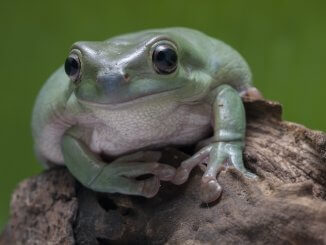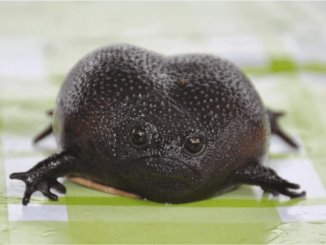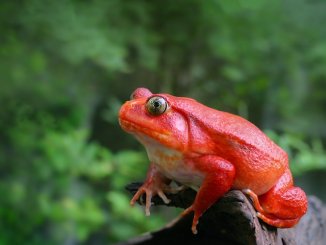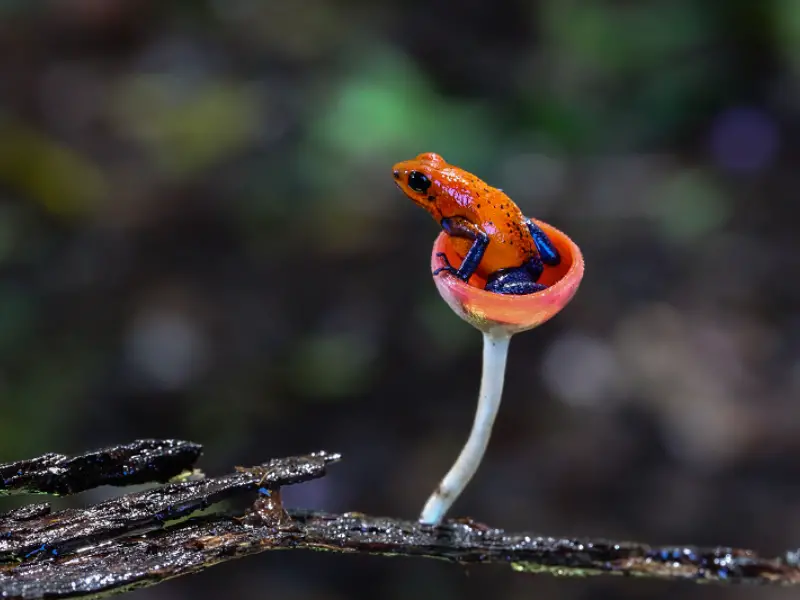
This gorgeous herp is part of a huge family of poison dart frogs (Dendrobatidae) and is one of the most desired by amphibian keepers. With as many as 30 color morphs, these beautiful frogs make a great addition to any experienced herptile enthusiast’s collection.
Note that we said, “experienced.” This is important. Strawberry darts are extremely sensitive critters, and we only recommend them if you’ve got a strong track record keeping amphibians.
If you’re ready to take on the challenge, you’ll find that these frogs are as compelling as they are gorgeous. Check out our complete care guide and species profile below!
What is a Strawberry Poison Dart Frog?
The strawberry poison dart frog (Oophaga pumilio) is native to much of Central America. It’s commonly found in Nicaragua, Costa Rica, and Panama and prefers to live in low-lying, forested areas.
About That Poison…
Like all dendrobatidae, it’s incredibly poisonous. It’s not the most toxic member of the family – that dubious honor goes to the golden poison frog, possibly the most poisonous known animal, who never gets invited over at Frog Christmas.
However, the strawberry dart has more than enough poison to kill an adult human within minutes if ingested. Their poison comes from the insects they consume and is their primary defense mechanism against predators. In nature, bright colors typically indicate that eating something is a bad idea, and this frog is no exception.
We’ll cover handling requirements for these fatal beauties later, but for now, note that you won’t die simply by touching a strawberry dart. Of course, it’s a different story if you touch the frog and then use the same hand to eat a sandwich.
If you touch the frog by accident, wash your hands very thoroughly with soap before touching any other surfaces, and you’ll likely suffer no ill effects.
Popularity & Scarcity
These are among the most popular poison dart variants in the U.S. This is partly due to their incredible range of color morphs. Estimates suggest that there are as many as 30 color morphs known, although rare morphs may cost more. As the name suggests, the most frequent color for these critters is strawberry red. Enthusiasts often share pictures and information about these vibrant creatures on social media.
Sadly, as with virtually all animals that people want to keep as pets, these amphibians are sometimes illegally captured and traded. This is especially true of rare color morphs, as they can fetch very high prices. Be aware.
Now for the good news – you can acquire a strawberry dart legally in the U.S. with confidence that it’s been sourced ethically. As always, this depends on finding a trustworthy breeder or seller, doing your homework, and everything else we expect all herp enthusiasts to do when finding a new pet.
Quick Facts
| Common name | strawberry poison dart frog, strawberry poison frog, “blue jeans”* |
| Scientific name | Oophaga pumilio |
| Adult size | 1"-2.5" |
| Lifespan | 10-15+ years |
| Diet | ants, fruit flies, springtails, pinhead crickets |
| Tank size | 20" x 12" x 10" or 10 gallons |
| Humidity & temperature | 75-80% rising to 100% during daily misting; 70F at night, 80-82F during the day |
| Popular alternatives | (all poison dart frog variants): “green and black”; “dyeing”; “bumblebee”; “reticulated” |
*Some color morphs are given unique names – the “blue jeans” variant is perhaps the most sought-after in the U.S.
Strawberry Poison Dart Frog Care Sheet
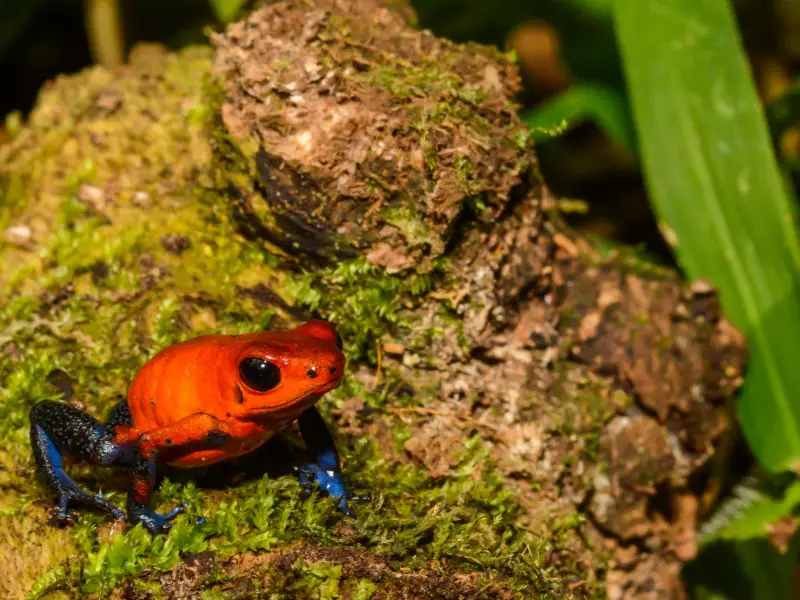
Caring for a strawberry dart requires research and dedication. Darts are picky about their substrate, and there’s little room for error with heating requirements. They also require plenty of shade.
The thing that many novice amphibian keepers forget is humidity, or rather, spraying the tank regularly. Strawberry darts like to have their tank sprayed twice daily. Forgetting this is among the main reasons these frogs aren’t recommended for beginners – a cat will tell you when it’s thirsty. A frog won’t.
Tank Requirements
Strawberry darts are more than happy in a standard 10-gallon tank. We recommend 20″ x 12″ x 10″, but small variations don’t matter too much.
The main issue with smaller tanks is that there may not be enough space to add all the furnishings they need for a comfortable environment. Meanwhile, an oversized tank is harder to keep as humid as they like.
Lighting and Heating
You may not need to install any heating elements in the tank, as these frogs live happily at room temperature. However, it’s worth monitoring the ambient temperature in the room you plan to install the tank.
If you’re averaging 70-80F in summer, it’ll likely get too cold in winter, so a low-power lightbulb could make a huge difference in the tank. Lighting can also help maintain live plants, which the frog will love (as long as they’re healthy!)
These frogs have an even photoperiod – they require around 12 hours each of light and darkness. Along with misting the tank, forgetting to provide adequate light and darkness is a frequent rookie mistake. This will stress the frog out and could make it ill over time.
Humidity
Humidity should be kept at around 75-80% except for when you mist the frog’s tank. You should do this twice daily, once in the morning and once in the evening.
Missing one misting won’t kill the frog, and if you find that the tank tends to remain extremely humid after misting, you may only need to do it once per day (nighttime is best). However, misting is the best way to keep the tank at the ideal humidity, and high humidity is much less damaging than low humidity.
Equally important is using water that won’t harm the frog. Amphibians absorb water through their skin, and our tap water is chlorinated, so spraying freshly poured tap water into the tank is a great way to expose your pet to toxic chlorine.
There are a few ways to ensure you’re using frog-safe water:
- Use spring water. Bottled spring water hasn’t been treated like tap water, so it’s perfectly safe for misting.
- Buy a dechlorination device. These are available at most pet stores selling herps or fish. You can also buy one online – dechlorination time varies depending on the device, so check the instructions.
- Leave the water out for 2 days. The gases in tap water evaporate naturally – it just takes a while. 2 days of standing time will ensure that the chlorine has fully evaporated. This is the cheapest method, and one evaporation session will give you enough water for several mistings.
Substrate
Strawberry poison frogs become pickier about substrate as they age. Moist paper towels serve well enough for young frogs, but ideally, you should provide 2-3″ substrate including:
- Coconut coir. This is affordable and easy to use. It’s also a great growing medium for mosses and any plants you’d like to keep in the tank.
- Orchid bark. This provides great drainage and is available at many pet stores or online.
- Sphagnum moss. The frog will appreciate the humidity this retains, and it adds a gorgeous touch to your tank. Tropical mosses are even better, although many herp enthusiasts find them difficult to maintain. It’s better to have a healthy, plain substrate than a problematic but attractive layer!
You’ll also need a drainage layer to ensure the bottom of the tank doesn’t become waterlogged. Large gravel pieces are easy and affordable – this layer should be 1-2″ thick and protected by window screening. Otherwise, the substrate will fall down and block gaps in the drainage layer.
Furnishings
Strawberry poison frogs love shelter. They’ll become stressed if they feel constantly exposed.
Coconut husks are a great way to provide some shade with minimal maintenance. If you can maintain healthy plants in your terrarium, these will also provide great cover and help create a natural environment for the frog. Plus, your terrarium will look amazing!
Small bromeliads are a perfect choice for a poison dart frog terrarium, especially if you’re considering breeding them. Poison dart frogs have a well-documented love of bromeliads, and these plants are easy to maintain as long as you provide a substantial drainage layer below the substrate.
Large leaves (e.g., oak, magnolia) are also a great addition, as they provide cover for the frog and will sustain live food.
Fake plants are also a sound choice. Again, if you’re not confident maintaining a full ecosystem in your tank, it’s better to choose a low-maintenance option than investing in a bunch of tropical plants that repeatedly get ill and die. This is expensive and doesn’t do your frog any good.
You should provide a very shallow bowl of water so the frog can bathe when it wants. This also helps maintain ambient humidity. Be careful not to add any deep water features, as these frogs can’t swim.
What Do They Eat?
As they’re such tiny animals, strawberry darts have fairly limited feeding options. However, fruit flies are an ever-abundant choice that they’ll take to happily.
Other options include:
- Pinhead crickets
- Termites
- Aphids
- Springtails
Especially for younger frogs, it’s recommended that you dust their food with a mineral supplement once per week. Even the most accurate terrarium diet won’t quite match what they find in the wild.
These frogs should be fed every 2-3 days. We suggest you check for residual, uneaten food when you go to feed your frog. If you find your frog frequently has leftover food after 3 days, it may be stressed or sick.
How to Keep Them Healthy
These frogs enjoy a clean environment, and any problems that can’t be resolved by improving environmental conditions (e.g., increasing humidity) may require specialist help.
Tank Cleaning
You should spot-clean the tank every 1-2 days. If you’re using natural plants and mosses, keep an eye out for disfigured or sickly plants – your frog won’t enjoy these, and they should be removed or trimmed as appropriate. Cut leaves should also be removed and replaced weekly.
Spot cleaning of the tank’s walls should be done with clean, hot water – ideally, this should be dechlorinated, as it will contribute to the tank’s humidity levels. Wipe surfaces dry with clean paper towels once clean.
Full cleaning should be done every few months. This will involve:
- Changing the substrate
- Cleaning the drainage layer
- Cleaning furnishings
- Intensively scrubbing the walls – you can use a 10 parts water/1 part bleach solution, but the best method is simply hot water and elbow grease
- Cleaning the light
- Adding new plants if desired
Vet Visits
Before you buy a strawberry poison dart frog, it’s advisable to find a local vet specializing in exotic pets, especially amphibians.
Knowing a good vet is 100% essential for herp enthusiasts. Strawberry darts can become stressed and fall sick due to extremely mild climate changes, and there’s nothing worse than not knowing what the problem is as your pet suffers.
How Long Do Strawberry Poison Dart Frogs Live?
The average lifespan in captivity is 10-15 years. It’s unclear how long they typically live in the wild.
Exceeding 15 years isn’t uncommon, and some strawberry darts have been reported to live for over 20 years. If cared for properly, they’re among the most rewarding long-term amphibian companions.
Strawberry Poison Dart Frog Behavior
Captive-raised strawberry darts are typically much more docile and hardy than wild-caught frogs. Mixing wild and farm-raised frogs isn’t recommended, as they’re accustomed to different conditions and may become aggressive toward each other.
Captive-bred strawberry dart frogs are often harder to find than captured specimens, as strawberry darts are incredibly difficult to breed in captivity. However, they’re more likely to have been sourced ethically and adapt to terrarium conditions much more readily.
These frogs aren’t aggressive – they’re rather shy. They enjoy shade and shelter, and the best time to see them is when they’re happily feeding.
Handling
You shouldn’t handle poison dart frogs except when absolutely necessary. There are two main reasons.
- The frog doesn’t like it. These amphibians are shy, retiring creatures that don’t enjoy contact with humans or any animals other than other poison darts or their prey! They’ve spent aeons developing a striking color scheme that says, “don’t touch me.” It’s best to respect that.
- They’re incredibly poisonous. Poison dart frogs contain enough poison to lay you out in minutes – if you eat them. You won’t, but handling these frogs is a cross-contamination risk. The less you touch them, the better; if you have to handle your frog, wear gloves and wash them thoroughly after handling.
Bonus reason: they’re tiny, and they jump. If you take your frog out of the tank to show it to a friend, there’s a good chance it’ll just hop out of your hands and vanish. For such brightly-colored animals, they’re very, very good at hiding.
This will present a fatal outcome for the frog and a serious health risk to everyone in your home. Don’t handle them unless you’re cleaning the tank, and try to keep it brief and gentle.
Appearance
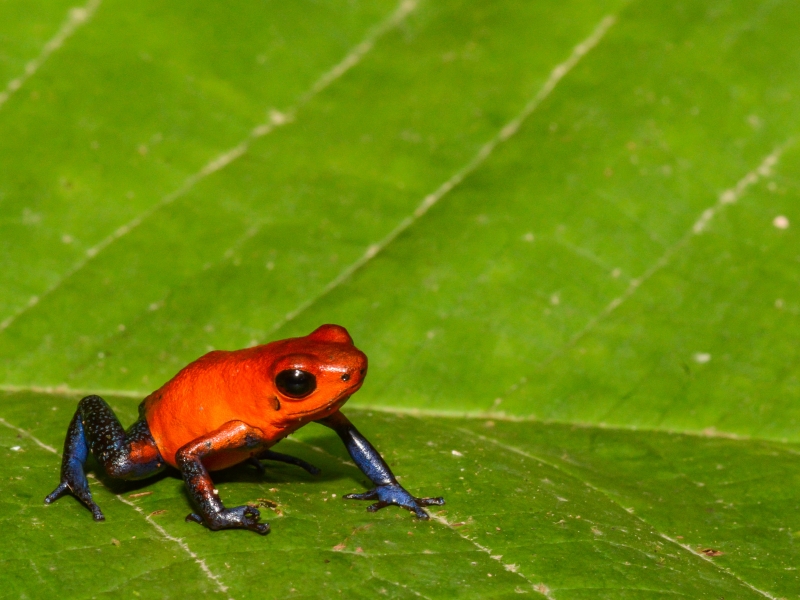
Strawberry poison darts are tiny and brightly colored, like most frogs in the dendrobatidae family.
Size
It’s very rare for these frogs to exceed 1.5″. Most captive-bred frogs are between 0.5″ and 1″.
Despite their small size, they’re easy to spot in a terrarium thanks to their incredible color displays.
Colors
Strawberry darts are among the most popular of all poison darts because of their incredible color range. Their namesake strawberry-red coloring is considered among the most beautiful of all frogs, and the 30-odd color morphs only add to the frog’s desirability for herp enthusiasts.
Typically, a strawberry dart will be mostly scarlet. Well-known morphs include blue or cream-colored legs and feet. Many frogs also have black spots on their back.
The underbelly may also be partly colored blue, and it often has an iridescent sheen.
If you’re lucky enough to find a rare strawberry dart morph, ensure it’s coming from a licensed breeder or reputable purveyor before buying it.
Breeding Strawberry Poison Dart Frogs
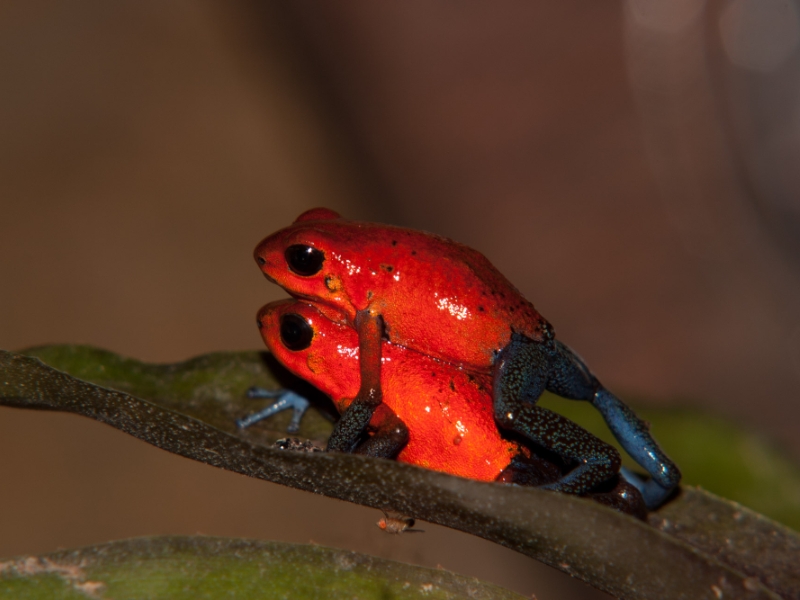
This species doesn’t take to breeding in captivity. Experienced breeders have spent years trying to persuade strawberry darts to breed, but even the slightest problem with their environment can ruin it all.
Here’s what to know if you want to breed strawberry darts.
- Most eggs won’t hatch. Eggs are laid in clusters of 3-10, and if 1-2 hatch, you’ve done very well.
- The photoperiod matters. Drop the light conditions during October and November. The frogs will become semi-dormant and won’t require as much misting or feeding. Continue this until late March or April.
- Start misting heavily in April. You’ll need to mist the tank 2-4 times per day to retain high humidity. They’re accustomed to heavy rainfall when breeding after a long, slow winter.
- Keep bromeliads. These plants are where the frogs naturally lay their eggs. A film canister can act as a substitute, but bromeliads are instinctively familiar.
Parents will take care of tadpoles in the early stages, but once they develop into froglets, the young desire separation. The most successful breeders have often separated strawberry dart froglets into separate terrariums.
How Much Do Strawberry Poison Dart Frogs Cost?
Strawberry darts cost between $25 and $70. However, rare morphs may cost significantly more. Ensure you’re purchasing your frog from a reputable breeder or seller, and never base your decision on the lowest price.
Summary
Strawberry poison dart frogs are incredibly rewarding pets – but they need their creature comforts. Setting up your terrarium properly is an essential first step. Understanding the frogs’ daily needs is the next. Strawberry darts require a great deal of love and care, and if you give it to them, they’ll thrive for many years.
If you’re an experienced amphibian owner and are ready to take on a new challenge, these beautiful frogs are a perfect choice!

